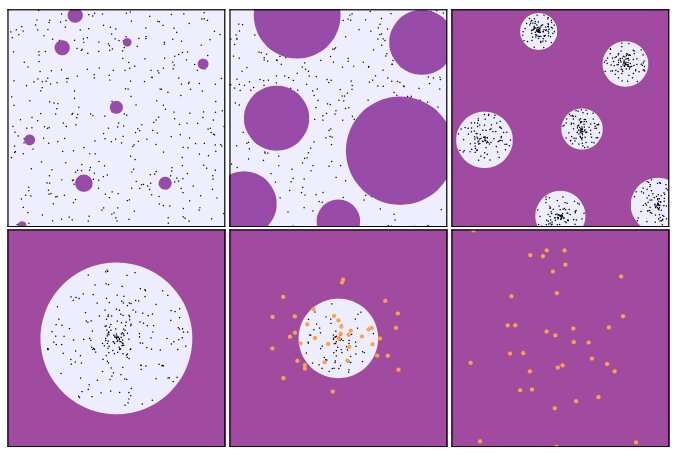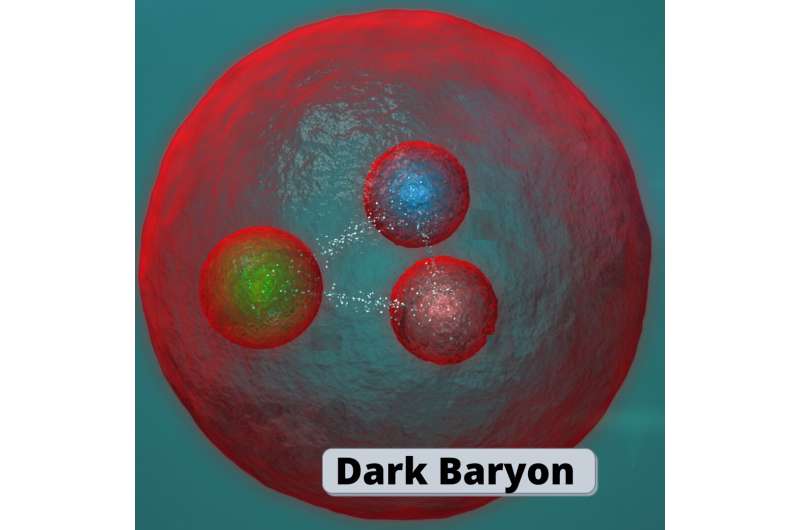December 6, 2021 feature
Study explores phase transitions in a confining dark sector using QCD simulations

Researchers at Massachusetts Institute of Technology, Hebrew University of Jerusalem, and Ohio state University recently carried out a study examining the possible effects of a first-order phase transition in a confining dark sector with heavy dark quarks. Using computer simulations, they showed that in several scenarios, such a transition could lead to a sizable reduction in the abundance of dark matter. The results of their analyses were published in Physical Review Letters.
"Our work builds upon a body of literature that is investigating confining phase transitions in the early universe, starting from a seminal paper by Edward Witten," Juri Smirnov, one of the researchers who carried out the study, told Phys.org. "When Witten wrote his paper, the dynamics of the non-abelian theories were not as well understood as today, a development that is due to a lot of progress in high-performance computing."
While the scenario described by Witten in his paper is not applicable to the strong force described by the standard model, a dark matter sector that exclusively contains heavy quarks would theoretically behave in the ways he described in his work. However, previous studies looking at heavy quark dark sectors neglected the effects of phase transitions, which ultimately led to incorrect conclusions.
This gap in the literature inspired Smirnov and his colleagues to carry out a new study that specifically examined the possible effects of a first-order phase transition in a heavy quark dark sector. Their work was enabled by the emergence of simulation tools that were previously unavailable.
"The fact that data from computational (lattice QCD) simulations of so-called gluonic theories is now available allowed us to use methods of thermodynamics to understand what would qualitatively happen in such a system," Smirnov said. "Using the input quantities of heat released per unit volume, as well as bubble wall surface tension, we were able to describe how bubbles of the confined phase (the energetically favored one) nucleate and expand, taking over the entire space."

Using simulations of gluonic theories, Smirnov and his colleagues were able to show that in a broad class of scenarios, specifically where dark matter is long-lived due to a conserved quantity (the so-called dark baryon number), a significant reduction in the abundance of dark matter is unavoidable. This would typically lead to dark matter masses that are orders of magnitude larger than previously predicted.
"Our findings suggest that we might need to rethink search strategies for such heavy particles," Smirnov said. "Our calculations are very general and only weakly depend on the details of the theory, such as, for example, the exact type of dark matter and visible matter interaction."
Interestingly, the mechanism unveiled by the researchers is also applicable to different scenarios that are related to the one they examined. More specifically, it could also be applied to instances where dark compact objects can form. This possibility was explored in a paper by another team of researchers at University of Pisa, which was based on this recent work.
The research could thus serve as a basis for new studies exploring phase transitions in heavy quark dark sectors and in other related scenarios. In their next studies, the researchers plan to investigate confining dark sectors with heavy quarks further, particularly exploring how the interaction between dark barons and known particles might look like. The results of these works could ultimately pave the way towards the development of alternative strategies to search for dark matter.
"Our work, by predicting very heavy dark matter, allows us to ask the following question: What if dark matter does not interact weakly with our world, but just rarely?" Smirnov said. "In other words, if dark matter particles are very heavy, they would be hard to find, just because their number density in the universe is low, even if their interaction with our matter was substantial. This question can lead to different search strategies, such as surface or space based dark matter detectors, instead of underground searches, as sufficiently strongly interacting particles would not reach underground detectors at a large enough speed to trigger a signal."
More information: Pouya Asadi et al, Accidentally Asymmetric Dark Matter, Physical Review Letters (2021). DOI: 10.1103/PhysRevLett.127.211101
Edward Witten, Cosmic separation of phases, Physical Review D (2002). DOI: 10.1103/PhysRevD.30.272
Andrea Mitridate et al, Dark matter as a weakly coupled dark baryon, Journal of High Energy Physics (2017). DOI: 10.1007/JHEP10(2017)210
Christian Gross et al, Dark Matter as dark dwarfs and other macroscopic objects: multiverse relics?, Journal of High Energy Physics (2021). DOI: 10.1007/JHEP09(2021)033
Journal information: Physical Review Letters , Physical Review D
© 2021 Science X Network



















